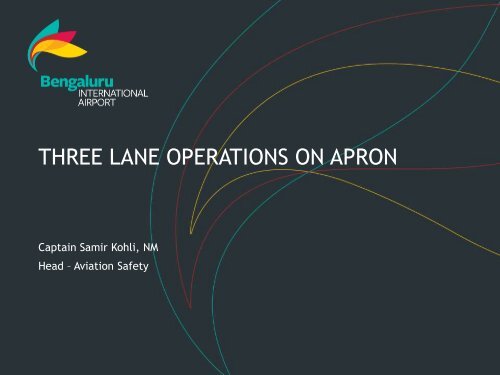Three lane procedures on Apron - ACI Objective. To provide the ...
Three lane procedures on Apron - ACI Objective. To provide the ...
Three lane procedures on Apron - ACI Objective. To provide the ...
- No tags were found...
Create successful ePaper yourself
Turn your PDF publications into a flip-book with our unique Google optimized e-Paper software.
THREE LANE OPERATIONS ON APRONCaptain Samir Kohli, NMHead – Aviati<strong>on</strong> Safety
<strong>Objective</strong><strong>To</strong> <strong>provide</strong> <strong>the</strong> participants with an overview of <strong>the</strong><str<strong>on</strong>g>Three</str<strong>on</strong>g> taxi <str<strong>on</strong>g>lane</str<strong>on</strong>g> operati<strong>on</strong>s <strong>on</strong> <strong>the</strong> Apr<strong>on</strong> of BengaluruInternati<strong>on</strong>al Airport including <strong>the</strong> problemsencountered in design and operati<strong>on</strong>s al<strong>on</strong>g withsoluti<strong>on</strong>s implemented.
Purpose of <str<strong>on</strong>g>Three</str<strong>on</strong>g> <str<strong>on</strong>g>lane</str<strong>on</strong>g> taxi system• Growing Air traffic• Enhances capacity• Reduces flight delays• Lowers infrastructure cost
<strong>ACI</strong> Apr<strong>on</strong> Markings and Signs Handbook
Internal Discussi<strong>on</strong>s• Need for three taxi-<str<strong>on</strong>g>lane</str<strong>on</strong>g>s c<strong>on</strong>sidered essential to beable to meet anticipated traffic within <strong>the</strong> given areaof apr<strong>on</strong>.• Recognized as a “Capacity Enhancement measure”,needing an aer<strong>on</strong>autical study including a „Hazard andRisk mitigati<strong>on</strong> exercise‟.• Involvement of Pilot groups and Air Traffic Managersc<strong>on</strong>sidered essential for proper decisi<strong>on</strong> making.• Safety Acti<strong>on</strong> Group (SAG) formed chaired by AirportsHead – Aviati<strong>on</strong> Safety to c<strong>on</strong>duct <strong>the</strong> study, carry outhazards and risk mitigati<strong>on</strong> and obtain approval from<strong>the</strong> DGCA (Aviati<strong>on</strong> Regulator)
Aer<strong>on</strong>autical Study• Included experts in <strong>the</strong> fields of Airside operati<strong>on</strong>almanagement, apr<strong>on</strong> management, air trafficmanagement, airport certificati<strong>on</strong> auditors, aircrewcertificati<strong>on</strong> inspectors, fleet commanders from 3 majorcarriers (each with >25% market share), GHAs, FlightCaterers, Into p<str<strong>on</strong>g>lane</str<strong>on</strong>g> Fuelling agents and cargo operators.• Met seven times over 14 m<strong>on</strong>ths.• Carried out a detailed study of traffic projecti<strong>on</strong>s,parking stands requirements and internati<strong>on</strong>al standards& recommended practices for Apr<strong>on</strong> c<strong>on</strong>structi<strong>on</strong> as wellas operati<strong>on</strong>s.• Detailed hazard identificati<strong>on</strong> and risk analysis, usingICAO matrix.
ICAO SARPs• An 14 Secti<strong>on</strong> 5.2.8.1: Taxiway centre line marking shallbe <strong>provide</strong>d <strong>on</strong> a paved taxiway, de-icing/anti-icing facility andapr<strong>on</strong> where <strong>the</strong> code number is 3 or 4 in such a way as to<strong>provide</strong> c<strong>on</strong>tinuous guidance between <strong>the</strong> runway centre lineand aircraft stands.• Doc 9157 Part 4 Secti<strong>on</strong> 2.3.12: “…primary line should be for<strong>the</strong> most critical aircraft, i.e. <strong>the</strong> aircraft requiring <strong>the</strong>greatest maneuvering area.”• Doc 9157 Part 4 Secti<strong>on</strong> 2.3.13: The guide lines shouldnormally be c<strong>on</strong>tinuous solid yellow lines at least 15 cm, butpreferably 30 cm, in width. However, where a sec<strong>on</strong>daryguide line is <strong>provide</strong>d, it should be a broken line todistinguish it from <strong>the</strong> primary line. Additi<strong>on</strong>ally, <strong>the</strong> type ofaircraft that is to follow each line should be clearly indicated.
Result• Accepted <strong>the</strong> need for three taxi <str<strong>on</strong>g>lane</str<strong>on</strong>g>s.• Pilot groups unanimously disagreed with <strong>ACI</strong>recommendati<strong>on</strong>s <strong>on</strong> use of Orange and Blue color <strong>on</strong>grounds of poor wet pavement visibility of <strong>the</strong>se colors.• Recommended <strong>on</strong>ly yellow color markings with embedded1.9µ refractive index glass beads and black border.• Recommended broken lines for Code C and below andc<strong>on</strong>tinuous line for Code D/E aircraft.• Recommended Nose-wheel-over-line type of markings,specifically Coat Hangar type of marking, for all aircraft <strong>on</strong>argument of airports legal liability to <strong>provide</strong> wing tipseparati<strong>on</strong> guidance up to stand stop bar.• Recommended use of Multi user stands.
Final design of apr<strong>on</strong> recommendedL1 L2 L322 M22 M26 M26 M16 M65 M16 M36 M 36 M8 M 8 M8 M
Apr<strong>on</strong> as built (1/2)Phraseology: “Turn left/right <strong>on</strong> L1/L2/L3 for stand …”“taxi to stand … Via Left/Right <strong>on</strong> L1/L2/L3”“Left/Right for stand …. Via L1/L2/L3”Use of “TO” prohibited after L1, L2 or L3 to avoidc<strong>on</strong>fusi<strong>on</strong> with “TWO”
Apr<strong>on</strong> as built (2/2)
Some Pictures
Operati<strong>on</strong>al C<strong>on</strong>ceptHDCode D/EstandsCode CstandsInitial designati<strong>on</strong> of TL1/TL2/TL3 was revised to L1/L2/L3 <strong>on</strong> <strong>the</strong>request of Air Traffic service <strong>provide</strong>r, Airports Authority of India.
Wing span limitati<strong>on</strong>s and Lanedesignati<strong>on</strong>s
Operati<strong>on</strong>al Problems• Aircraft missing right turn to Link „H‟ while taxiing out of <strong>the</strong>Apr<strong>on</strong> and <strong>the</strong>refore c<strong>on</strong>tinuing into cargo apr<strong>on</strong>.• Code C Aircraft taxiing into neighboring Code D/E stands.• Pilots report difficulty in estimating turn path over curved lines.• Night visibility of lines during heavy rain.• Push back separati<strong>on</strong>s and illusi<strong>on</strong>s.
Aircraft missing turn to link „H‟
Code C aircraft entering neighboring CodeD/E stands (1/2)EARLIERNOW
Code C aircraft entering neighboring CodeD/E stands (2/2)EARLIERNOW
Estimating turn path over curvesChanged from 2 m line - 2 mgap to 3 m line - 1 m gap
Night visibility of lines during heavy rains• C<strong>on</strong>tinues to be a problem area.• Centre line lighting being c<strong>on</strong>templated.• Progressive centre line lighting not possible <strong>on</strong> a threetaxi <str<strong>on</strong>g>lane</str<strong>on</strong>g> apr<strong>on</strong> due complexity of traffic movementand MARS.• We look at centre <str<strong>on</strong>g>lane</str<strong>on</strong>g> lighting in Blue color overyellow <str<strong>on</strong>g>lane</str<strong>on</strong>g>s.• Point in debate: Multicolor lines as recommended by<strong>ACI</strong> al<strong>on</strong>g with respective color lights i.e. Orange,Yellow and Blue instead of <strong>on</strong>ly Blue.
Push back separati<strong>on</strong>s and illusi<strong>on</strong>s• Calculati<strong>on</strong> of push back separati<strong>on</strong>s is a complicated process withMARS. Initially flight delays encountered as maintaining 80 mbehind Code C and 250 m behind Code D/E aircraft translated toblocking 5 and 11 stands respectively.• Soluti<strong>on</strong> found by permitting aircraft to cross from L1 to L3 withguidance of a follow-me vehicle.
Promulgati<strong>on</strong>• AIP (India) supplement• NOTAM – Code C aircraft to remain <strong>on</strong> broken lines<strong>on</strong>ly <strong>on</strong> <strong>the</strong> Apr<strong>on</strong>. Code D/E aircraft should neverattempt to follow a broken line.• Interacted with Jeppesen for correcti<strong>on</strong> to apr<strong>on</strong>charts published by <strong>the</strong>m.• Pilot guidance handbook published and circulated toairlines for pilot briefing• Direct interacti<strong>on</strong> with Airlines Safety departmentsand Flight Dispatchers to ensure standard pilotbriefing c<strong>on</strong>tent modified.
Standard development• Color of Taxi Lanes. Issue of wet pavement visibility ofOrange and Blue colors Vs Yellow needs to be scientificallyaddressed.• Centre line lighting <strong>on</strong> a three <str<strong>on</strong>g>lane</str<strong>on</strong>g> apr<strong>on</strong> should be astandard. Progressive lighting is not possible.• VDGS installati<strong>on</strong> <strong>on</strong> a three <str<strong>on</strong>g>lane</str<strong>on</strong>g> apr<strong>on</strong> should be astandard.• Specificati<strong>on</strong> of broken lines <strong>on</strong> a curve: ICAO 2 m line – 2m gap. We recommend: 3 m line, 1 m gap.• Do we really need nose-wheel-over-line markings? If so,are Coat Hangar type markings suitable for Code C andbelow aircraft or are <strong>the</strong>y required <strong>on</strong>ly for Code D/Eaircraft? How <strong>the</strong>n can we merge that into a MARS typeapr<strong>on</strong>? Why not have just a straight line to stand?
Thank You03 March, 2009

















